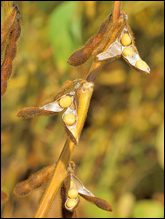Dear Umbra,
I’m interested in learning more about the treatment and genetic modification of soy and how prevalent this is. I think a lot of folks choose products such as soy milk because they think they are making a better choice for the earth, as well as themselves. I think this is an overlapping issue and qualifies for your help. Perhaps a slant toward educating us on the state of soy farming and production would be an acceptable angle for you.
Cheryl
Sierra Club, San Diego Chapter
San Diego, Calif.
Dearest Cheryl,
Your wish is my command. Or maybe my wish was your command: I was hoping to get an inquiry about the environmental impacts of soy production, and what should show up but your letter?

As of 2004, 85 percent of the U.S. soy crop was genetically modified, accounting for some 63.6 million acres of soybeans. The top GM soy states form a shape like a slice of pizza in the middle of the country: from the Dakotas and the plains states down the Mississippi River and back up into Ohio and the Michigan mitten. Statistics for 2003 indicate that at least 55 percent of soy worldwide is now genetically modified.
Roundup Ready soy is produced, patented, sold, and beloved by the Monsanto Company, which also manufactures the herbicide Roundup. Roundup (glyphosate) is a popular and effective killer of broadleaf plants. I don’t know if you’ve seen a soybean plant, but take my word for it: The leaves are broad. That posed a bit of a problem for both farmers and Monsanto: glyphosate applications on soy plants had to be timed to avoid damage to the crop, and thus were of limited use.
The development of soy that’s resistant to Roundup was a boon for farm business and for Monsanto. Schedule and dose limitations on glyphosate spritzing have been greatly reduced. Some would like us to believe that glyphosate spritzing itself has been greatly reduced, that “herbicide-tolerant” soy has led to less need for the herbicide. This is not the case. The use of Roundup and other pesticides and herbicides on genetically modified crops in the U.S. from 2001 through 2003 increased by tens of millions of pounds compared to non-GM conventional agriculture. Glyphosate is not a safe herbicide. It’s not Agent Orange, but nor is it orange juice. Sacrificial mice and rats have gotten various tumors, irritated membranes, cancers, dead sperm, etc., from exposure to Roundup.
But why must I be so negative? Certainly I can say some positive things about soy. It’s an amazing and astonishingly versatile plant. Why, it’s in baby food, oils, delicious packaged cookies, breads — you know, rather than keep going, I’ll just point you to the Illinois Soybean Association website, which combines two of my favorite things: agriculture and pirates. If you don’t follow that link to hear what Cap’n Soy has to say, you still need to know that your conscious consumption of soy products is likely a small fraction of your total consumption. Unless you eat a completely organic diet, or make everything you eat from scratch, you are eating genetically modified soybeans. (Check out this shopping guide from the True Food Network for a list of GM and non-GM brands.)
I don’t believe we environmentalists should be supporting genetically modified crops at this time. (More on this in past and future columns.) Hence, says this environmental advice columnist, our consumption of soy should be conscientious and careful.
Ahoyly,
Umbra


